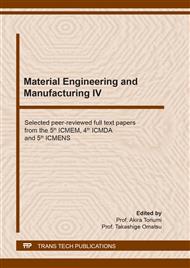[1]
Pacheco-Torgal, F. and Jalali, S. (2012), Earth construction: Lessons from the past for future eco- efficient construction,, in Construction and Building Materials, vol. 29, pp.512-519.
DOI: 10.1016/j.conbuildmat.2011.10.054
Google Scholar
[2]
Morton, T., Stevenson, F., Taylor, B. and Smith, N. C. (2005), Low cost earth brick construction. Monitoring and evaluation, Arc, UK.
Google Scholar
[3]
Shukla, A., Tiwari, G. and Sodha, M. S. (2008), Embodied energy analysis of adobe house,, in Renew Energy, vol. 34, pp.755-61.
DOI: 10.1016/j.renene.2008.04.002
Google Scholar
[4]
Danso, H., Martinson, B., Ali, M. and Mant, C. (2015), Performance characteristics of enhanced soil blocks: a quantitative review,, in Building Research & Information, vol. 43, issue 2, pp.253-262.
DOI: 10.1080/09613218.2014.933293
Google Scholar
[5]
Houben, H. and Guillaud, H. (1994), Earth construction: a comprehensive guide, Earth Construction Series, Intermediate Technology Publications, London.
Google Scholar
[6]
Morel, J.-C., Pkla, A. and Walker, P. (2007), Compressive strength testing of compressed earth blocks,, in Construction and Building Materials, vol. 21, issue 2, pp.303-309.
DOI: 10.1016/j.conbuildmat.2005.08.021
Google Scholar
[7]
Walker, P. and Stace, T. (1997), Properties of Some Cement Stabilised Compressed Earth Blocks and Mortars,, in Materials and Structures, vol. 30, pp.545-551.
DOI: 10.1007/bf02486398
Google Scholar
[8]
Millogo, Y. and Morel, J.-C. (2012), Microstructural Characterization and Mechanical Properties of Cement Stabilised Adobes,, in Materials and Structures, vol. 45, issue 9, pp.1311-1318.
DOI: 10.1617/s11527-012-9833-2
Google Scholar
[9]
Burroughs, S. (2006), Strength of Compacted Earth: Linking Soil Properties to Stabilizers,, in Building Research and Information, vol. 34, issue 1, pp.55-65.
DOI: 10.1080/09613210500279612
Google Scholar
[10]
Millogo, Y., Hajjaji, M. and Ouedraogo, R. (2008), Microstructure and Physical Properties of Lime-Clayey Adobe Bricks,, in Construction Building Materials, vol. 22, issue 12, pp.2386-2392.
DOI: 10.1016/j.conbuildmat.2007.09.002
Google Scholar
[11]
Ciancio, D., Beckett, C. T. S. and Carraro, J. A. H. (2014), Optimum lime content identification for lime-stabilised rammed earth,, in Construction and Building Materials, vol. 53, pp.59-65.
DOI: 10.1016/j.conbuildmat.2013.11.077
Google Scholar
[12]
Maskell, D., Heath, A. and Walker, P. (2014a), Comparing the environmental impact of stabilisers for unfired earth construction,, in Key Engineering Materials, vol. 600, pp.132-143.
DOI: 10.4028/www.scientific.net/kem.600.132
Google Scholar
[13]
Maskell, D., Heath, A. and Walker, P. (2014), Inorganic stabilisation methods for extruded earth masonry units,, in Construction Building Materials, vol. 71, pp.602-609.
DOI: 10.1016/j.conbuildmat.2014.08.094
Google Scholar
[14]
James, J., Pandian, P. K., Deepika, K., Venkatesh, J. M., Manikandan, V. and Manikumaran, P. (2016), Cement Stabilized Soil Blocks Admixed with Sugarcane Bagasse Ash,, in Journal of Engineering, vol. 2016, Article ID 7940239, pp.1-9.
DOI: 10.1155/2016/7940239
Google Scholar
[15]
Oti, J. E., Kinuthia, J. M. and Bai, J. (2009), Engineering properties of unfired clay masonry brics,, in Engineering Geology, vol. 107, issue 3-4, pp.130-139.
DOI: 10.1016/j.enggeo.2009.05.002
Google Scholar
[16]
Scalisi, F. (2010), Nanotecnologie in Edilizia. Innovazione tecnologica e nuovi materiali per le costruzioni, Maggioli, Santarcangelo di Romagna (RN).
Google Scholar
[17]
Yuan, P., Tan, D. and Annabi-Bergaya, F. (2015), Properties and applications of halloysite nanotubes: recent research advances and future prospects,, in Applied Clay Science, vol. 112-113, pp.75-93.
DOI: 10.1016/j.clay.2015.05.001
Google Scholar
[18]
Farzadina, N., Ali, A., Demirboga, R. and Parvez Anwar, M. (2013), Effect of halloysite nanoclay on mechanical properties, thermal behavior and microstructure of cement mortars,, in Cement and Concrete Research, vol. 18, pp.97-104.
DOI: 10.1016/j.cemconres.2013.03.005
Google Scholar
[19]
Kamble, R. Ghag, M., Gaikawad, S. and Kumar Panda, B. (2012), Halloysite Nanotubes and Applications: A Review,, in Journal of Advanced Scientific Research, vol. 3, issue 2, pp.25-29.
Google Scholar
[20]
Nasrollahzadeh, M., Sajadi, S. M., Sajjadi, M., Issaabadi, Z. and Atarod, M. (eds) (2019), An Introduction to Green Nanotechnology, Series Interface Science and Technology, vol. 28, Academic Press-Elsevier, London.
DOI: 10.1016/b978-0-12-813586-0.00002-x
Google Scholar
[21]
Lvov, Y. M., Shchukin, D. G., Mohwald, H. and Price, R. R. (2008), Halloysite clay nanotubes for controlled release of protective agents,, in ACS Nano, vol. 2, issue 5, pp.814-820.
DOI: 10.1021/nn800259q
Google Scholar
[22]
Zhang, Y., Tang, A., Yang, H. and Ouyang, J. (2016), Applications and interfaces of halloysite nanocomposites,, in Applied Clay Science, vol. 82, issue 1, pp.8-17.
DOI: 10.1016/j.clay.2015.06.034
Google Scholar
[23]
Lazzara, G., Cavallaro, G., Panchal, A., Fankhrullin, R., Stavitskaya, A., Vinokurov, V. and Lvov, Y. (2018), An assembly of organic-inorganic composites using halloysite clay nanotubes,, in Current Opinion in Colloid & Interface Science, n. 35, pp.42-50.
DOI: 10.1016/j.cocis.2018.01.002
Google Scholar
[24]
Lvov, Y and Elshad, A. (2013), Functional polymer-clay nanotube composites with sustained release of chemical agents,, in Progress in Polymer Science, n. 38, pp.1690-1719.
DOI: 10.1016/j.progpolymsci.2013.05.009
Google Scholar
[25]
Galán-Marín, C., Rivera-Gómez, C. and Petric, J. (2010), Clay-based composite stabilized with natural polymer and fibre,, in Construction and Building Materials, vol. 24, pp.1462-1468.
DOI: 10.1016/j.conbuildmat.2010.01.008
Google Scholar
[26]
Maskell, D., Heath, A. and Walker, P. (2015), Use of Metakaolin with stabilised extruded earth masonry units,, in Construction and Building Materials, vol. 78, pp.172-180.
DOI: 10.1016/j.conbuildmat.2015.01.041
Google Scholar
[27]
Maskell, D., Heath, A. and Walker, P. (2016), Appropriate structural unfired earth masonry units,, in Construction Materials, vol. 169, issue 5, pp.261-270.
DOI: 10.1680/jcoma.15.00034
Google Scholar


